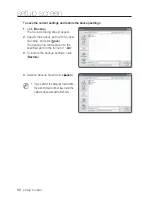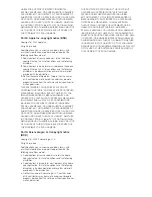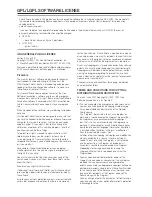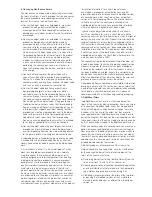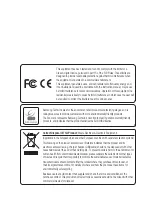
the work for making modifications to it. “Object code” means
any non-source form of a work.
A “Standard Interface” means an interface that either is
an official standard defined by a recognized standards
body, or, in the case of interfaces specified for a particular
programming language, one that is widely used among
developers working in that language.
The “System Libraries” of an executable work include
anything, other than the work as a whole, that (a) is included
in the normal form of packaging a Major Component,
but which is not part of that Major Component, and (b)
serves only to enable use of the work with that Major
Component, or to implement a Standard Interface for which
an implementation is available to the public in source code
form. A “Major Component”, in this context, means a major
essential component (kernel, window system, and so on) of
the specific operating system (if any) on which the executable
work runs, or a compiler used to produce the work, or an
object code interpreter used to run it.
The “Corresponding Source” for a work in object code form
means all the source code needed to generate, install, and (for
an executable work) run the object code and to modify the
work, including scripts to control those activities. However,
it does not include the work's System Libraries, or general-
purpose tools or generally available free programs which are
used unmodified in performing those activities but which are
not part of the work. For example, Corresponding Source
includes interface definition files associated with source files
for the work, and the source code for shared libraries and
dynamically linked subprograms that the work is specifically
designed to require, such as by intimate data communication
or control flow between those subprograms and other parts
of the work.
The Corresponding Source need not include anything that
users can regenerate automatically from other parts of the
Corresponding Source.
The Corresponding Source for a work in source code form is
that same work.
2. Basic Permissions.
All rights granted under this License are granted for the term
of copyright on the Program, and are irrevocable provided
the stated conditions are met. This License explicitly affirms
your unlimited permission to run the unmodified Program.
The output from running a covered work is covered by this
License only if the output, given its content, constitutes a
covered work. This License acknowledges your rights of fair
use or other equivalent, as provided by copyright law.
You may make, run and propagate covered works that you
do not convey, without conditions so long as your license
otherwise remains in force. You may convey covered
works to others for the sole purpose of having them make
modifications exclusively for you, or provide you with facilities
for running those works, provided that you comply with the
terms of this License in conveying all material for which you
do not control copyright. Those thus making or running the
covered works for you must do so exclusively on your behalf,
under your direction and control, on terms that prohibit them
from making any copies of your copyrighted material outside
their relationship with you.
Conveying under any other circumstances is permitted
solely under the conditions stated below. Sublicensing is not
allowed; section 10 makes it unnecessary.
3. Protecting Users' Legal Rights From Anti-
Circumvention Law.
No covered work shall be deemed part of an effective
technological measure under any applicable law fulfilling
obligations under article 11 of the WIPO copyright treaty
adopted on 20 December 1996, or similar laws prohibiting or
restricting circumvention of such measures.
When you convey a covered work, you waive any legal
power to forbid circumvention of technological measures to
the extent such circumvention is effected by exercising rights
under this License with respect to the covered work, and
you disclaim any intention to limit operation or modification of
the work as a means of enforcing, against the work's users,
your or third parties' legal rights to forbid circumvention of
technological measures.
4. Conveying Verbatim Copies.
You may convey verbatim copies of the Program's source
code as you receive it, in any medium, provided that you
conspicuously and appropriately publish on each copy an
appropriate copyright notice; keep intact all notices stating
that this License and any non-permissive terms added in
accord with section 7 apply to the code; keep intact all
notices of the absence of any warranty; and give all recipients
a copy of this License along with the Program.
You may charge any price or no price for each copy that you
convey, and you may offer support or warranty protection for a
fee.
5. Conveying Modified Source Versions.
You may convey a work based on the Program, or the
modifications to produce it from the Program, in the form of
source code under the terms of section 4, provided that you
also meet all of these conditions:
a) The work must carry prominent notices stating that you
modified it, and giving a relevant date.
b) The work must carry prominent notices stating that
it is released under this License and any conditions
added under section 7. This requirement modifies the
requirement in section 4 to “keep intact all notices”.
c) You must license the entire work, as a whole, under this
License to anyone who comes into possession of a copy.
This License will therefore apply, along with any applicable
section 7 additional terms, to the whole of the work, and
all its parts, regardless of how they are packaged. This
License gives no permission to license the work in any
other way, but it does not invalidate such permission if you
have separately received it.
d) If the work has interactive user interfaces, each must
display Appropriate Legal Notices; however, if the Program
has interactive interfaces that do not display Appropriate
Legal Notices, your work need not make them do so.
A compilation of a covered work with other separate and
independent works, which are not by their nature extensions
of the covered work, and which are not combined with it
such as to form a larger program, in or on a volume of a
storage or distribution medium, is called an “aggregate” if the
compilation and its resulting copyright are not used to limit
the access or legal rights of the compilation's users beyond
what the individual works permit. Inclusion of a covered work
in an aggregate does not cause this License to apply to the
other parts of the aggregate.

